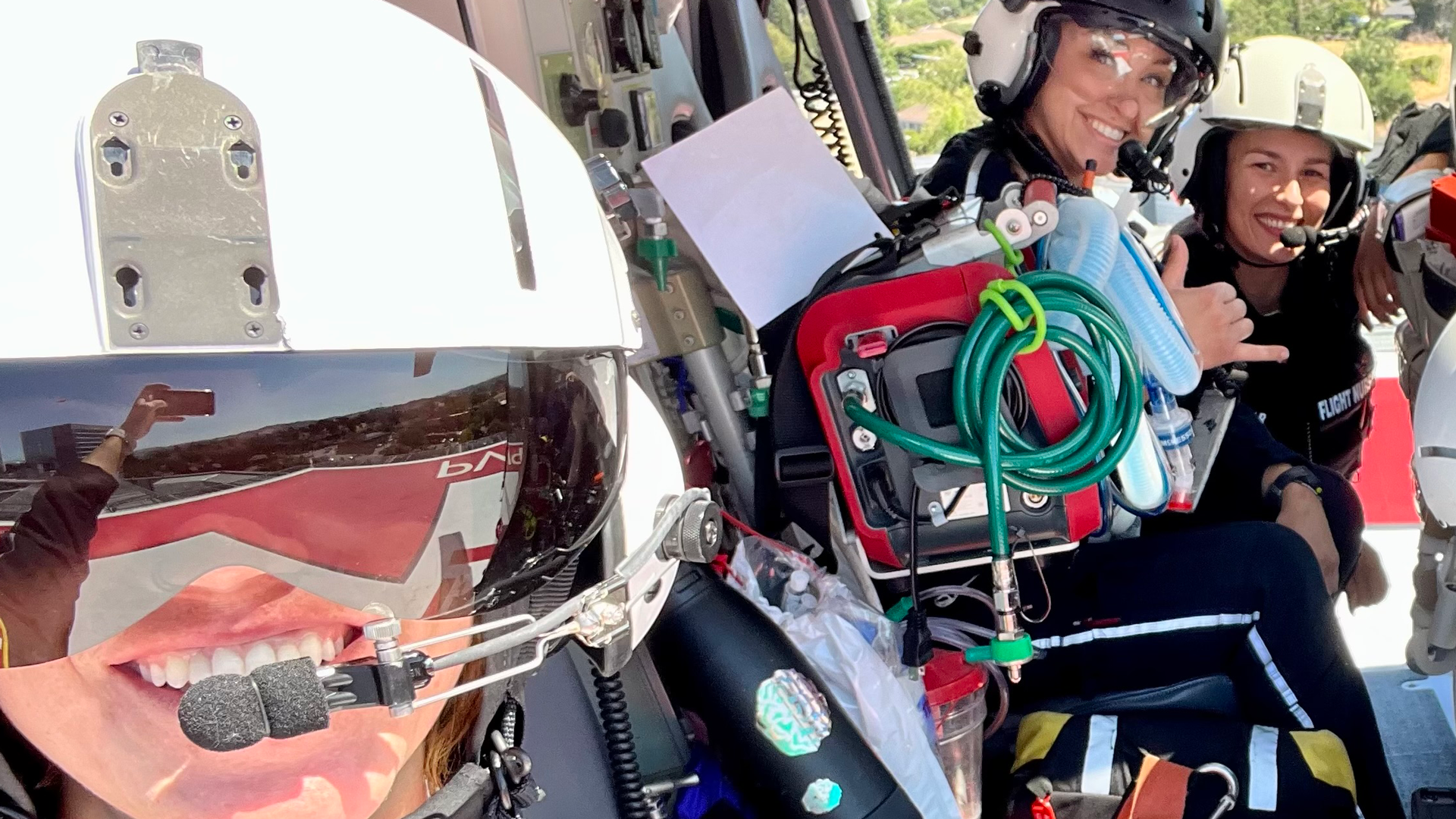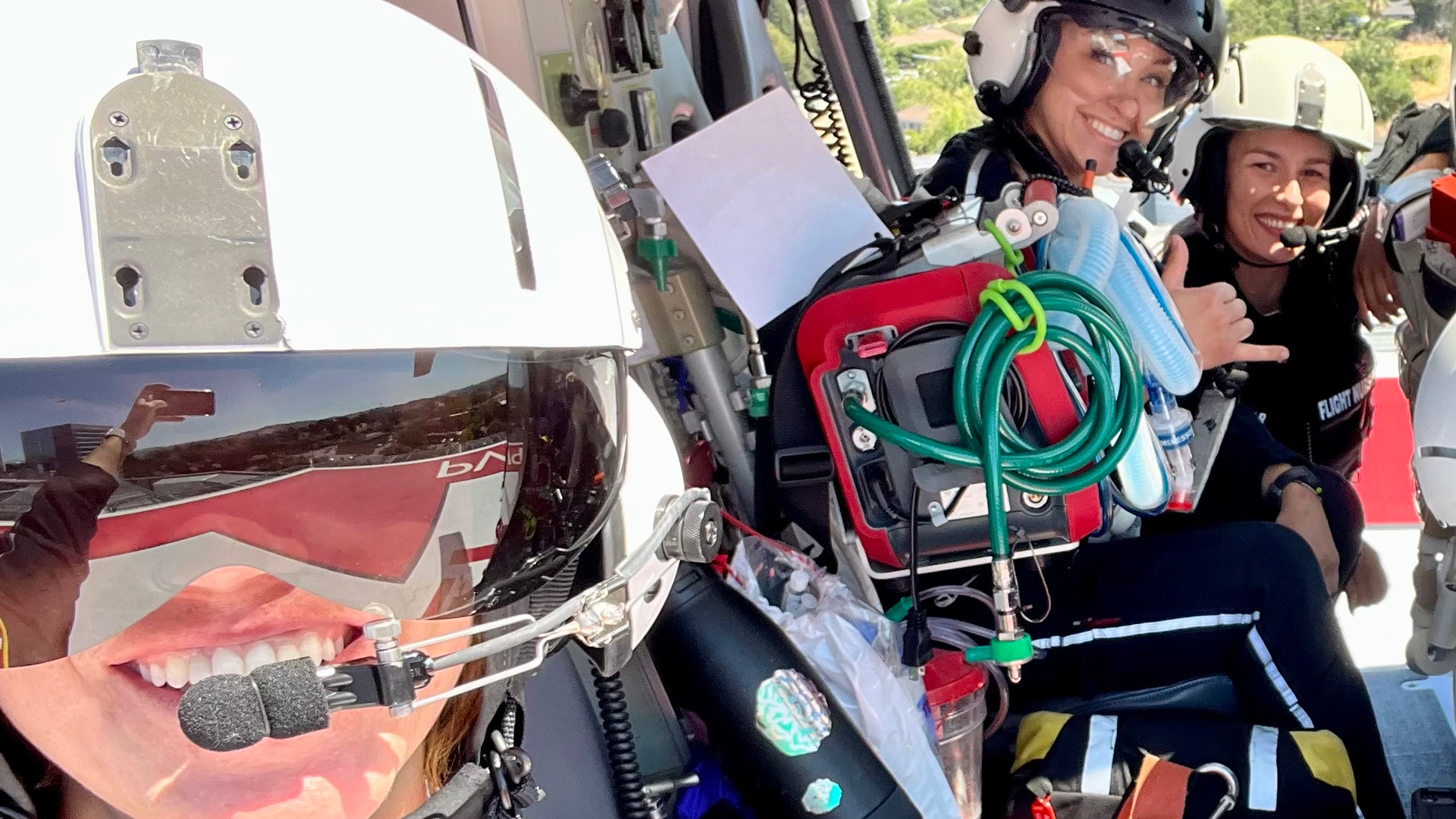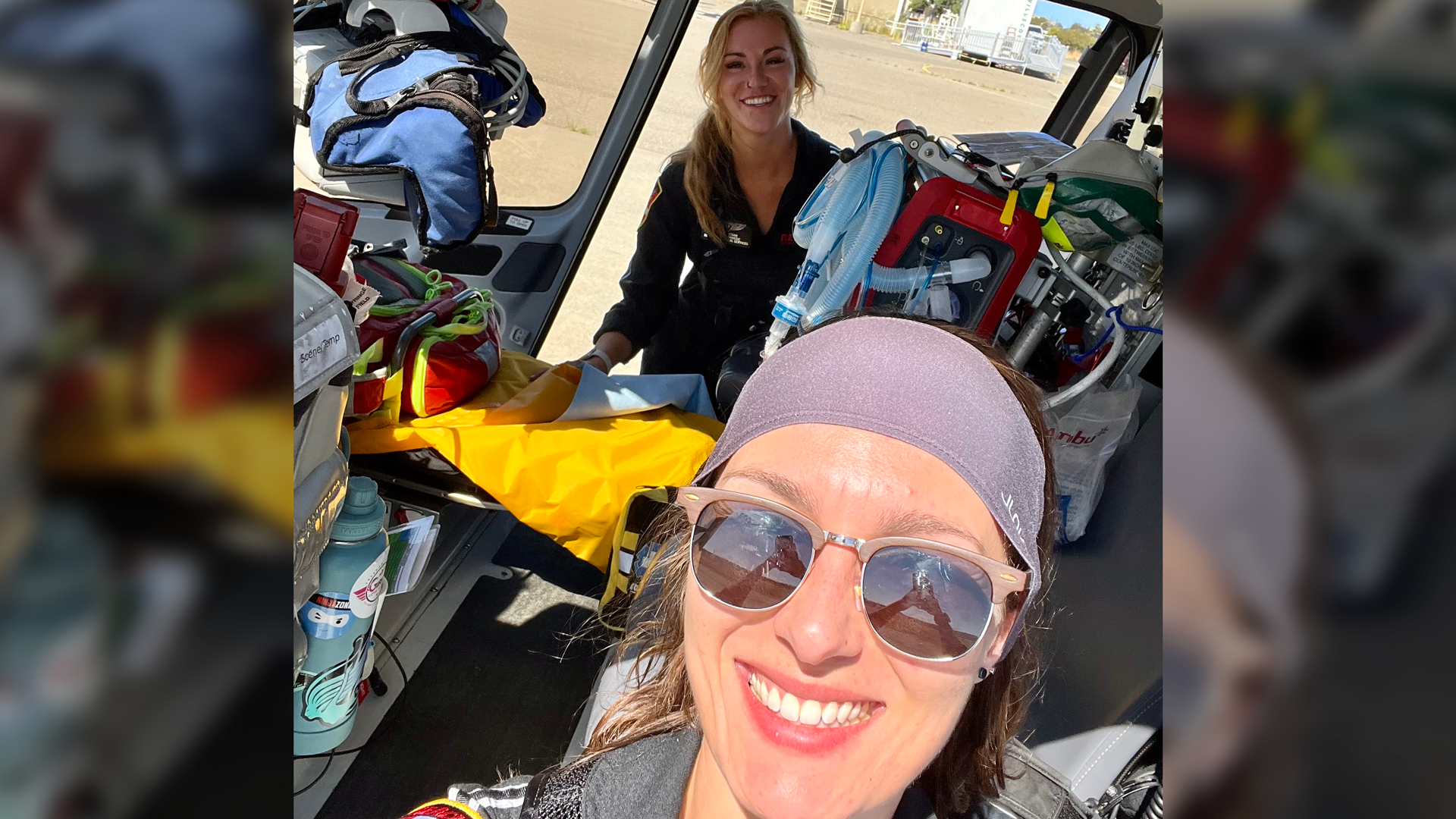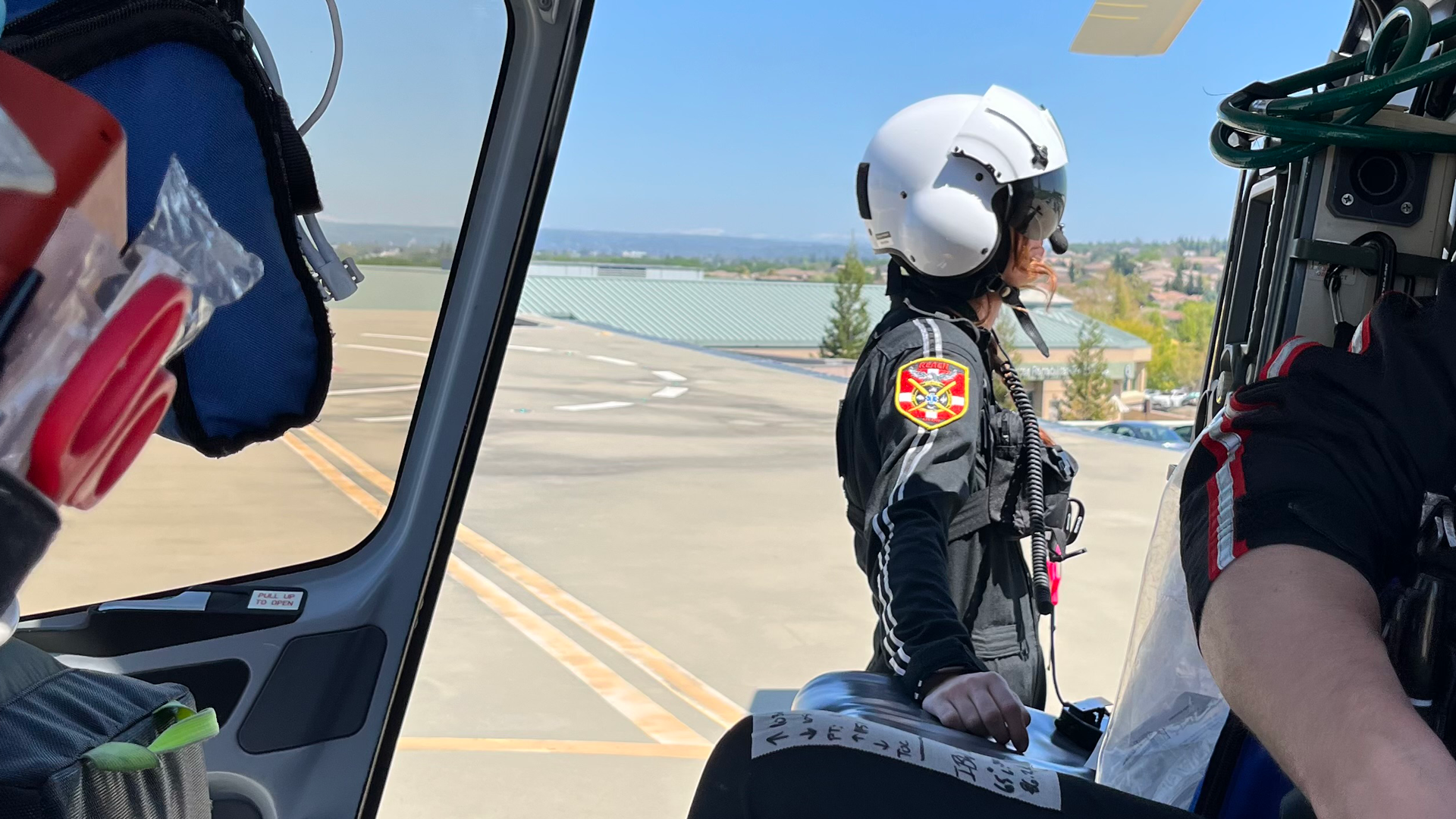For the Sake of the Baby
September 18, 2023
A California REACH crew’s clinical expertise prevents a tragic outcome for a breech baby.
As anyone knows who’s ever been on the frontlines in the EMS profession, the difference between life and death can sometimes come down to a few seconds. But as important as it is to know when and how to quickly administer care, it’s equally valuable to know when “not” to step in, but rather reassess, step back and let someone else intervene.
Such was the case in early August 2023, when crewmates Rachel Starr and Mikala Parker of REACH Air Medical Services in Stockton, California responded to a pre-dawn call for a pregnant patient who needed advanced care at another hospital.
“It was around 4 a.m. when we got the call,” says Starr, flight paramedic with REACH, a Global Medical Response solution. “I remember arriving at the patient’s hospital bedside and seeing her so distraught and in distress. That’s what made us even more determined to remain focused on our mission, which was the welfare of the patient and her baby. That was our top priority.”
And as part of fulfilling that “top priority,” Starr and her partner, Parker, a flight nurse, requested doctors do a “second” pelvic exam on the patient to ensure the safety of the patient and baby. Little did they know at that moment, that simple request would make all the difference in the well-being of the infant.
“During that second exam, it became clear that the baby had moved,” said Parker. “The baby’s foot had moved, and the infant was struggling to get oxygen. It simply wasn’t safe for us to mobilize and take the patient and her unborn baby into our care at that time.”
Parker and Starr immediately called for the patient to be rushed to surgery for a C-section delivery, avoiding a precipitous delivery of a 31-week, breech baby, which could have been disastrous had they made the flight with the patient on board.
“We get so much training in our profession that we know how to look out for signs that would indicate we need to reevaluate the situation, and for many EMS personnel, a call concerning a high-risk OB patient is an example of that type of scenario,” said Starr.
“Exposure, exposure, exposure,” said Parker, who adds that their clinical experience in dealing with high-risk patients has only made her and Starr stronger in their role as EMS first responders.
“Starr and I are like a ‘black cloud,’ we’re prepared for the worst, but every once in a while, we experience ‘Zebra stripes,’ and that means there’s a break in that ‘black cloud’ and hope gives way. It’s not all bad, and that’s where our training has made such a huge impact in bringing about a good outcome in what would have otherwise been bad.”
And for that mother and baby in early August, that was exactly the case.
Starr and Parker not only made a judgement call that resulted in the safe delivery of that breeched baby, but also stayed at the hospital, consulting and interacting with on-site doctors and clinicians, ensuring both patients were safe and stable. Additionally, they activated a specialized neonatal intensive care unit (NICU) team, which arrived at the hospital to continue care and safely move both patients to another facility where they would receive advanced treatment.
“In our line of work, there are always wins and losses,” said Starr. “The losses are hard to forget; they do sit with us, but that’s why it’s important to remember the wins, too. That’s what helps us do our jobs.”
Parker agrees.
“We do a lot of debriefing after every call we respond to, so it’s ingrained in our thinking on how to handle high-risk medical situations. For that call in August, it was for the sake of the baby we made our decision to not take the mother-to-be/patient in our care,” said Parker. “It was the right call, and our training is what helped us make it. EMS is a tough profession to be in, but I wouldn’t change it for a second. I am exactly where I am supposed to be, and I’m doing exactly what I am supposed to do.”
Such was the case in early August 2023, when crewmates Rachel Starr and Mikala Parker of REACH Air Medical Services in Stockton, California responded to a pre-dawn call for a pregnant patient who needed advanced care at another hospital.
“It was around 4 a.m. when we got the call,” says Starr, flight paramedic with REACH, a Global Medical Response solution. “I remember arriving at the patient’s hospital bedside and seeing her so distraught and in distress. That’s what made us even more determined to remain focused on our mission, which was the welfare of the patient and her baby. That was our top priority.”
And as part of fulfilling that “top priority,” Starr and her partner, Parker, a flight nurse, requested doctors do a “second” pelvic exam on the patient to ensure the safety of the patient and baby. Little did they know at that moment, that simple request would make all the difference in the well-being of the infant.
“During that second exam, it became clear that the baby had moved,” said Parker. “The baby’s foot had moved, and the infant was struggling to get oxygen. It simply wasn’t safe for us to mobilize and take the patient and her unborn baby into our care at that time.”
Parker and Starr immediately called for the patient to be rushed to surgery for a C-section delivery, avoiding a precipitous delivery of a 31-week, breech baby, which could have been disastrous had they made the flight with the patient on board.
“We get so much training in our profession that we know how to look out for signs that would indicate we need to reevaluate the situation, and for many EMS personnel, a call concerning a high-risk OB patient is an example of that type of scenario,” said Starr.
“Exposure, exposure, exposure,” said Parker, who adds that their clinical experience in dealing with high-risk patients has only made her and Starr stronger in their role as EMS first responders.
“Starr and I are like a ‘black cloud,’ we’re prepared for the worst, but every once in a while, we experience ‘Zebra stripes,’ and that means there’s a break in that ‘black cloud’ and hope gives way. It’s not all bad, and that’s where our training has made such a huge impact in bringing about a good outcome in what would have otherwise been bad.”
And for that mother and baby in early August, that was exactly the case.
Starr and Parker not only made a judgement call that resulted in the safe delivery of that breeched baby, but also stayed at the hospital, consulting and interacting with on-site doctors and clinicians, ensuring both patients were safe and stable. Additionally, they activated a specialized neonatal intensive care unit (NICU) team, which arrived at the hospital to continue care and safely move both patients to another facility where they would receive advanced treatment.
“In our line of work, there are always wins and losses,” said Starr. “The losses are hard to forget; they do sit with us, but that’s why it’s important to remember the wins, too. That’s what helps us do our jobs.”
Parker agrees.
“We do a lot of debriefing after every call we respond to, so it’s ingrained in our thinking on how to handle high-risk medical situations. For that call in August, it was for the sake of the baby we made our decision to not take the mother-to-be/patient in our care,” said Parker. “It was the right call, and our training is what helped us make it. EMS is a tough profession to be in, but I wouldn’t change it for a second. I am exactly where I am supposed to be, and I’m doing exactly what I am supposed to do.”

.png)

